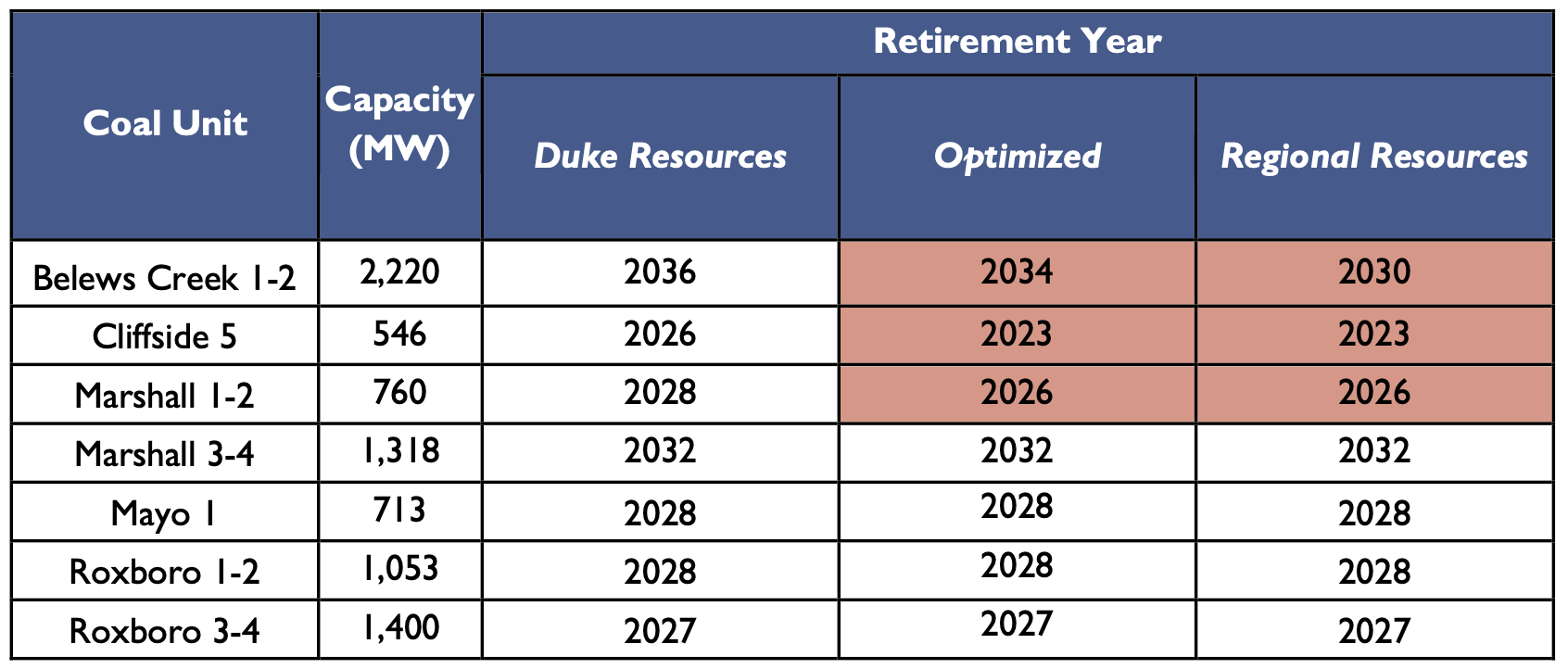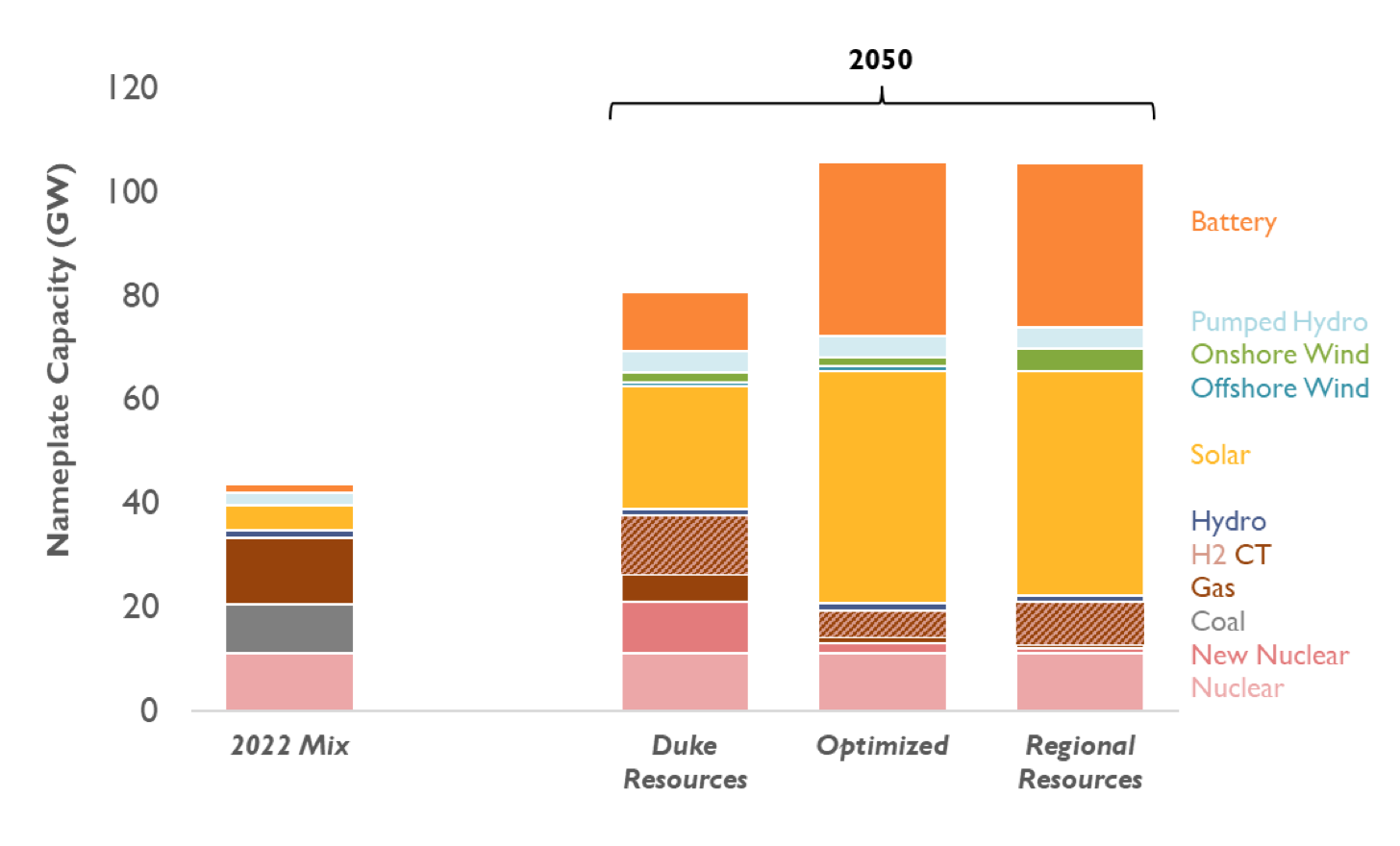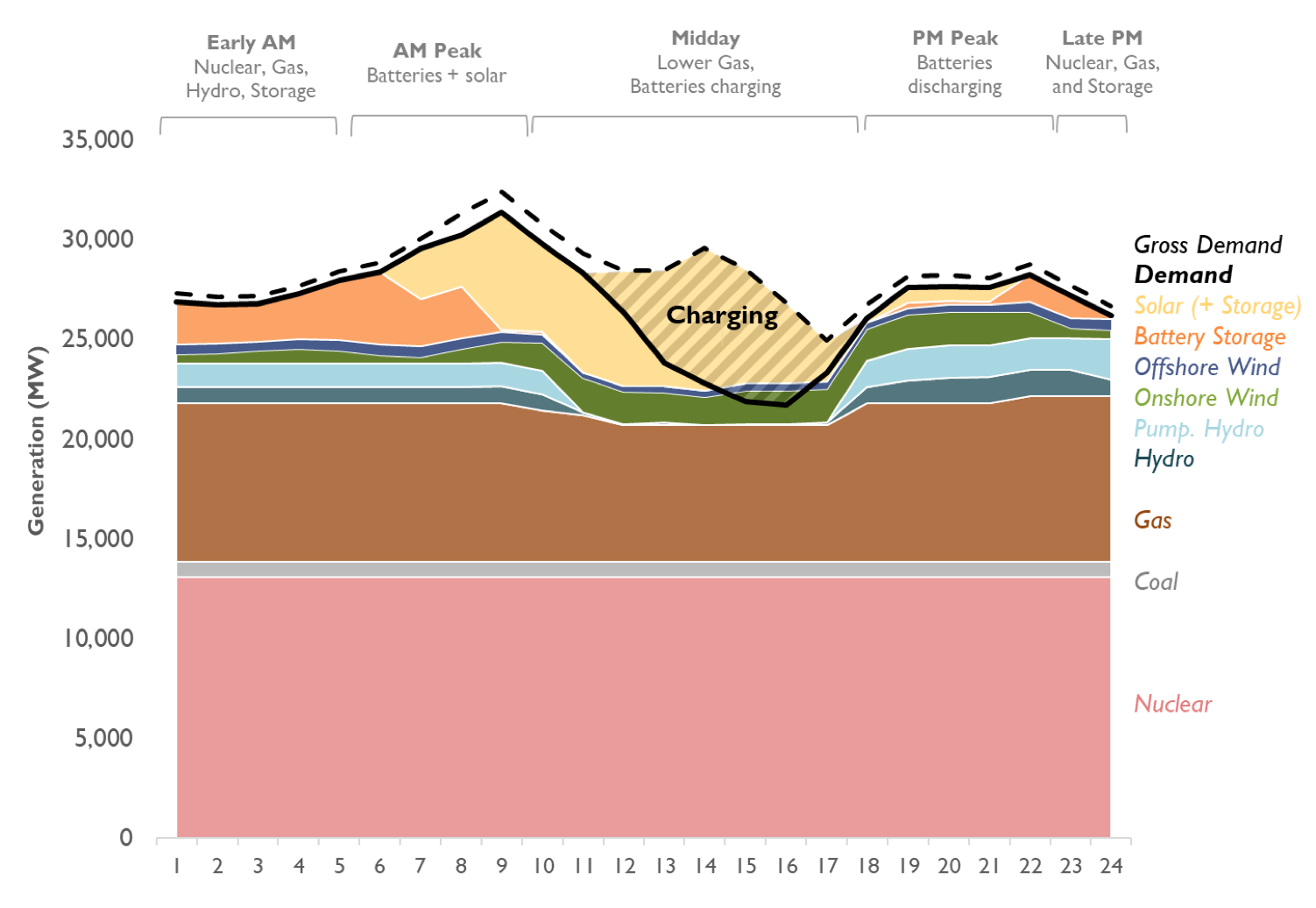A Lower-Cost, Lower-Carbon Plan
After Duke Energy filed its proposed carbon plan with the NC Utilities Commission on May 16, clean energy advocates were given 60 days to digest the nearly 900-page document and prepare other options. For a refresher on interpretations and analysis of Duke’s proposed plan, check out this article.

On July 20, North Carolina Sustainable Energy Association (NCSEA), the Southern Environmental Law Center (SELC), the Natural Resources Defense Council (NRDC), the Southern Alliance for Clean Energy (SACE), and the Sierra Club jointly filed comments and carbon plan modeling to the Commission. This article discusses key differences and advantages of the Synapse modeling presented by clean energy advocates that address concerns of the utility’s proposed plan.
Achieving Emissions Reductions Requirements
As a quick reminder, the NC Utilities Commission (NCUC) was directed by the General Assembly via House Bill 951: Energy Solutions for NC to create a carbon plan by December 31, 2022, outlining the pathway to achieving 70% emissions reductions by 2030 and carbon neutrality by 2050. The first steps in this directive included Duke Energy (Duke) convening three stakeholder meetings to inform their own proposed carbon plan filing made on May 16. Advocates and third parties then had only 60 days, until July 15, to file their own proposals for a carbon plan. Following this, the NCUC will now continue to convene a series of public hearings to ensure additional voices are considered in drafting the plan, all leading up to the final order given at the end of the year.
The carbon plan order issued by the NCUC will be a hugely significant milestone in utility regulation in the state, potentially marking an inflection point representative of a new era of emissions reductions and clean generation resources.
“It’s a major opportunity to shape the world we live in and raise our families in,” said Mikaela Curry, senior representative for the Sierra Club’s Beyond Coal campaign in the Carolinas.
Before we get to that point, though, it’s important to digest some of the filings made to date, including Duke’s proposed scenarios. To note, only one of the four scenarios in Duke’s proposed carbon plan, P1, actually meets the emissions reductions mandates of 70% by 2030 codified by HB 951.
Further, the utility advocates for additional natural gas generation resources to the tune of 2 gigawatts (GW). Where additional firm Appalachian gas transport capacity is assumed to be unavailable, however, red flags are unearthed red flags in this P1 scenario. When modeled without this new gas transport capacity, whether due to the cancellation of the Atlantic Coast Pipeline or the uncertain future of the Mountain Valley Pipeline, Duke’s own production cost modeling found that P1-Alternate would also fall short of achieving 2030 carbon reduction targets. Synapse modeling showed the potential of its scenarios to achieve emissions reduction requirements, illustrated in Table 1: Carbon Emissions by Scenario.
Table 1: Carbon Emissions by Scenario (Source: Synapse Report pg. 24)

More concerning is the reliance on this capital-intensive generation resource that may become outdated in the very near future, leading to the inevitability of early retirement similar to the current situation playing out with coal. This large-scale utility fossil generation buildout followed by early retirement and possibly securitization could potentially leave the ratepayer to foot the bill.
In addition, Duke’s proposed plan continues to drag its feet retiring coal-fired power plants, with some doors remaining open as late as 2036, detailed in Table 2: Retirement Year for Selected Coal Units, as modeled by Synapse for the clean energy advocates in each proposed scenario. The plan also relies heavily on unproven technologies like small nuclear reactors (SMRs) and zero-carbon hydrogen, rather than proven, scalable renewable energy sources like solar and wind to meet emission reductions goals moving forward.
Table 2: Retirement Year for Selected Coal Units, by Scenario (Source: Synapse Report pg. 19)

“Utility plans to invest in new gas power plants are risky on a number of fronts, particularly opening up customers to higher bills driven by volatile fuel prices and stranded assets,” said Maggie Shober, Research Director of SACE. “Our analysis shows that investments in energy efficiency, renewable energy, and storage are the best way to meet future electricity demand while managing the risk of higher customer bills in the future.”
A Better Path Forward for a Cleaner, More Certain Future
Prompted by these red flags, NCSEA and partners jointly filed comments and a carbon plan model to the NCUC on July 20. The group, collectively known as The Coalition of Low-Cost Energy And Net-Zero (CLEAN) Intervenors, presented data-driven modelling and analyses conducted by Synapse Economics Inc., RMI, and Grid Strategies LLC.
The carbon plan delivered by the CLEAN Intervenors provides the Commission with a more timely and cost-effective option to meet the legislatively mandated carbon reduction targets. Potential ratepayer savings are illustrated in Table 3: Net Present Value Revenue Requirements (NPVRR) over Time by Scenario. The plan clearly shows that widespread deployment of clean energy resources can effectively lower energy bills and provide reliable energy to communities across the state.
Table 3: Net Present Value Revenue Requirements (NPVRR) over Time by Scenario (Source: Synapse Report pg. 2)

“The modeling filed by NCSEA and our partners demonstrates that cleaner, proven technologies, like solar and wind, are hands-down the best option for ratepayers,” said Ward Lenz, Executive Director of NCSEA. “It should no longer be a question of cost versus carbon. We’re now seeing that lower carbon technologies are some of the most cost-effective options across the board, as seen in our modeling, which resulted in additional savings for Duke customers.”
Methodology and Modeling
RMI Study: NCSEA and SELC contracted with RMI to produce an analysis exhibiting the negative impacts that Duke’s proposed plan would have on ratepayers due to fuel price volatility. The analysis found that Duke’s plan does not sufficiently hedge against fuel price shocks and sensitivities, like much of the world continues to experience amidst a global pandemic and international conflict.
“Duke’s carbon plan is deeply flawed and relies too heavily on natural gas, nuclear energy, and risky investments in unproven technology,” explained Luis Martinez, Director of Southeast Energy at NRDC.
An accelerated deployment of renewable energy generation, as found in the CLEAN Intervenors modeling, would effectively mitigate this risk and insulate North Carolina from future price volatility and supply chain uncertainty.
Synapse Model: To produce the CLEAN Intervenors modeling, Synapse Energy Economics utilized EnCompass, the same software used by Duke to develop its plan, to create an ‘apples-to-apples’ comparison.
Synapse modeling constructed three scenarios to compare results, with EnCompass as a shared foundation. The following scenarios, depicted in Figure 1: Capacity by Resource Type, 2022 and 2050 by Scenario, highlight the specific strengths of each approach:
- Duke Resources: Provides a baseline for comparison. This scenario mimics the P1-Alternate scenario proposed in Duke’s carbon plan but uses a revised set of modeling inputs. Note, EnCompass performed a sensitivity to assess the impact of a Regional Greenhouse Gas Initiative (RGGI) on carbon emissions and found that RGGI would cause emission reductions of hundreds of thousands of tons per year in the coming decades, allowing this scenario to meet HB 951 mandates by 2030;
- Optimized: Utilizes Encompass’ economic optimization algorithm to select an economically optimal portfolio of resources, using revised model inputs and making more zero carbon resources available-energy efficiency, renewables, and battery storage; and
- Regional Resources: Allows software to select Midwest wind resources via power purchase agreements through PJM Interconnection.
Figure 1: Capacity by Resource Type, 2022 and 2050 by Scenario (Source: Synapse Report pg. 2)

Advantages of a Lower-Cost, Lower-Carbon Plan
The Synapse modeling demonstrates that the path to meeting North Carolina’s emissions reduction requirements is rooted in larger investments in existing clean technology. It is also clear that supporting widespread clean energy deployment calls for sufficient grid planning and infrastructure buildout.
The CLEAN intervenors’ carbon plan layers in key levers like securitization and price-based ratemaking, constructing better energy systems and saving North Carolinians more money on their energy bills.
On top of addressing the shortcomings of Duke’s proposed carbon plan, the CLEAN Intervenors’ modeling exhibits the following advantages across its scenarios:
- Cost savings: 2-7% by 2030 and 15-19% by 2050, compared to Duke Resources scenario. This includes NPVRR savings growing from $700 million-$2.4 billion and $17.7-$23.1 billion from 2030 to 2050, respectively;
- No new proposed natural gas: The Synapse scenarios do not select any additional buildout of combined-cycle (CC) or combustion turbine (CT) gas units in its portfolios. There is also less reliance on unproven, uncertain technologies like SMRs and zero-carbon hydrogen availability;
- Increased deployment of proven, scalable renewable energy: Significantly more solar, storage, and wind exist at the core of the Optimized scenario. This portfolio consists of 7.2 GW of solar and 5.6 GW of storage by 2030. By 2040, these figures grow to 22.5 GW of solar, 800 megawatts (MW) of offshore wind, 1.5 GW of onshore wind, and 17 GW of energy storage resources compared to today;
- Earlier retirements of coal and gas: By relying more on cleaner sources of electricity generation, 3.5 GW of coal capacity can be economically retired earlier than in Duke Resources proposal. Furthermore, in the final years of the Synapse planning period, between 800 and 1,300 MW of existing gas resources are economically retired, resulting in the avoidance of expensive utility retrofits to be able to burn hydrogen;
- Energy efficiency easing of grid pressure: The Synapse scenarios include energy efficiency savings of 1.5% of total retail load. Energy efficiency is an achievable, cost-effective pathway for the Duke Energy system to require 2% less energy by 2035 and 5% less energy by 2050, compared to the utility’s baseline assumptions. Energy efficiency alone would save ratepayers in North Carolina billions of dollars by 2050; and
- Collaborative regional purchase agreements: One of the additional scenarios proposed by the CLEAN Intervenors, Regional Resources, underlines the promise of regional coordination and transmission capabilities to provide cost-effective power to North Carolina. This particular portfolio utilizes onshore wind power purchases from the Midwest, allowing the system to procure cost-effective electricity and save ratepayers $1.7 billion by 2030 and $5.4 billion by 2050.
Comparing key differences to Duke’s plan, it’s clear that there is a better path forward, in both the near and long-term, for the energy transition. The CLEAN Intervenor’s modeling depicts a future where reliable, clean energy can be provided consistently, as seen in Figure 2: Winter Peak Generation by Technology, January 2040, Optimized Scenario. This future can be realized through expanding upon the true value of renewable energy and regional coordination to tackle the transmission and distribution challenge. Utility initiatives must also remain forward-thinking with grid planning, supported by prudent policy and regulation at the state and federal level.
“This modeling proves that we can meet state carbon-reduction requirements on time and in a cleaner and more affordable way than suggested by Duke. This new modeling also shows us a pathway that benefits the growth of our clean energy economy and creates a healthier environment for North Carolinians,” said David Neal, senior attorney with SELC. “Relying more on low-cost renewable energy and treating energy efficiency as a priority resource will continue to make our grid stronger and more reliable, costing less on customer bills than Duke’s proposals while bringing us a lower carbon future.”
Figure 2: Winter Peak Generation by Technology, January 2040, Optimized Scenario (Source: Synapse Report pg. 23)

Considerations for the Road Ahead
The carbon plan presented by the CLEAN Intervenors demonstrates a more timely and cost-effective pathway to achieving emissions reductions requirements in North Carolina. Because of this, NCSEA and its partners argue that the Commission should not rely solely on Duke Energy’s plan in its own modeling as it prioritizes investments in outdated, expensive, and high-emitting resources.
NCSEA is optimistic that North Carolina can achieve emissions reduction mandates through the adoption of a wholistic, forward-thinking approach. Significant progress has already been made via the deployment of clean energy resources leading to emissions reductions across multiple sectors like electric generation and transportation. We should be proud of the accomplishments made to date and motivated to build upon them in the coming years as we enter one of the most pivotal moments in the state’s energy history. Developing a carbon plan provides an opportunity to lay the foundation necessary to carry this momentum forward to accomplish legislative mandates in the coming years.
To learn more about the carbon plan process and the CLEAN Intervenors recent filing, check out the latest press release here and ways to get involved with the stakeholder process at the NCUC. Also, check out Episode 71 of the Squeaky Clean Energy Podcast to hear a conversation about the shortcomings of Duke’s proposed plan and the necessary measures needed to reach 70% carbon reduction by 2030.

